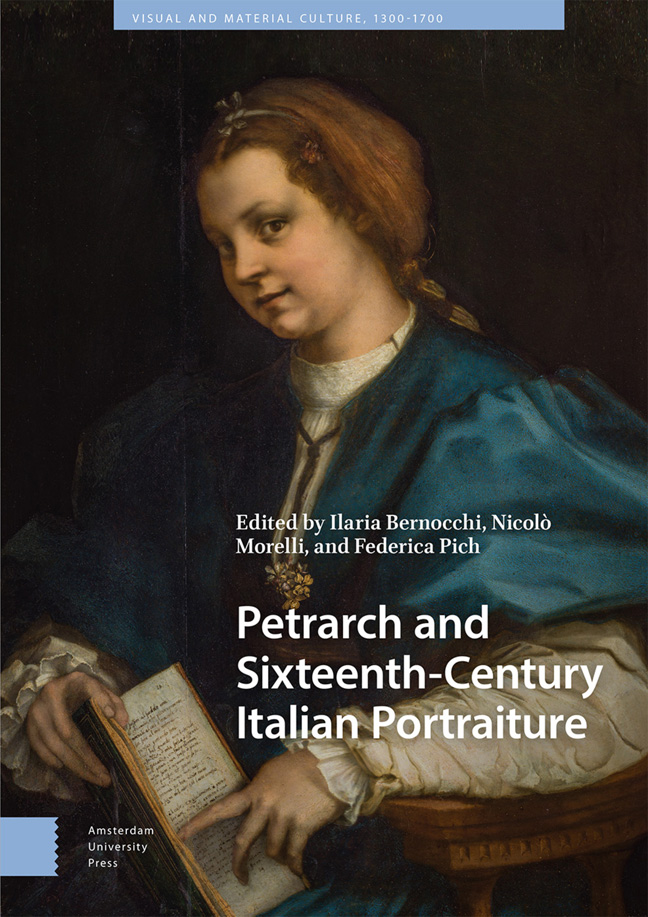Book contents
- Frontmatter
- Contents
- List of Illustrations
- Acknowledgements
- 1 Introduction
- 2 Widows, Poetry, and Portraits: Livia Spinola and Francesca Turina on the Portraits of their Dead Husbands
- 3 In Medusa's Eyes: Petrification and Marble Portraits in Late Sixteenth-Century Poetry
- 4 The Portrait of the Ideal Woman: Petrarch in Conduct Literature Texts for and about Women
- 5 Anti-Petrarchist Portraiture or a Different Petrarchist Portraiture?: A Literary Outlook on Some Non-Idealised Female Sitters in Renaissance Art
- 6 The Shadow of Petrarch: Benedetto Varchi and Agnolo Bronzino on Portraiture
- 7 Double Portraits of Petrarch and Laura in Print (c. 1544–1600)
- 8 Sonnet ‘Diptychs’ and Double Portraits: Figurative Allusions in Sixteenth-Century Encomiastic Poetry
- 9 Images of Women from Subject to Frame in Printed Portrait Books
- Bibliography
- Index
8 - Sonnet ‘Diptychs’ and Double Portraits: Figurative Allusions in Sixteenth-Century Encomiastic Poetry
Published online by Cambridge University Press: 22 February 2024
- Frontmatter
- Contents
- List of Illustrations
- Acknowledgements
- 1 Introduction
- 2 Widows, Poetry, and Portraits: Livia Spinola and Francesca Turina on the Portraits of their Dead Husbands
- 3 In Medusa's Eyes: Petrification and Marble Portraits in Late Sixteenth-Century Poetry
- 4 The Portrait of the Ideal Woman: Petrarch in Conduct Literature Texts for and about Women
- 5 Anti-Petrarchist Portraiture or a Different Petrarchist Portraiture?: A Literary Outlook on Some Non-Idealised Female Sitters in Renaissance Art
- 6 The Shadow of Petrarch: Benedetto Varchi and Agnolo Bronzino on Portraiture
- 7 Double Portraits of Petrarch and Laura in Print (c. 1544–1600)
- 8 Sonnet ‘Diptychs’ and Double Portraits: Figurative Allusions in Sixteenth-Century Encomiastic Poetry
- 9 Images of Women from Subject to Frame in Printed Portrait Books
- Bibliography
- Index
Summary
Abstract
In keeping with the Petrarchan precedent (Rvf 77–78), poems composed on the theme of the portrait of the beloved in the sixteenth century are often articulated in two interconnected parts. This bipartite structure, connected with the artistic subject, soon inspired a comparison with double portraits of spouses in the visual arts. By investigating the strategies and implications of this sophisticated process of ‘symbiosis’, this chapter attempts to demonstrate the existence of a vein of encomiastic and, in particular, dedicatory poetry that, without making explicit reference to visual counterparts, nevertheless uses the pairing of sonnets to create moral and celebratory ‘double portraits’ of sovereign couples.
Keywords: double portraits, Petrarchism, dedication, diptych
Among the many forms of sixteenth-century dedicatory text, there is one in particular that shows interesting analogies with portraits in the visual arts: paired dedicatory poems to rulers and their spouses. This type of text was first brought to scholarly attention by Maria Antonietta Terzoli, who, in her study of dedications in sixteenth-century poetry books, established a preliminary corpus:1 the pair of sonnets addressed to Henry II of France and Catherine de’ Medici, which opens the encomiastic and occasional section of Gaspara Stampa's Rime (1554); the two sonnets dedicated to Duchess Eleonora de Toledo and Duke Cosimo I de’ Medici at the beginning of Laura Battiferri's Primo Libro delle Opere Toscane (1560); the pair of sonnets dedicated by Modesta dal Pozzo de’ Zorzi (also known as Moderata Fonte) to the Grand Duke of Tuscany Francesco I de’ Medici and his wife Bianca Cappello at the opening of the Tredici canti del Floridoro (1581); and, finally, the dedicatory titles of the two sections of Maddalena Acciaiuoli Salvetti's Rime toscane (1590), which are dedicated to the Grand Duchess and Grand Duke of Tuscany, Christina of Lorraine and Ferdinando I de’ Medici.
This paper will be concerned exclusively with those dedicatory sonnets in Terzoli's corpus that are conceived as pairs and which are indicated here as ‘diptychs’. Although these diptychs appear in texts belonging to different literary genres, this does not seem to influence the form of the sonnets themselves, which conform instead to the strictly rhetorical norms and conventions of dedication, so the wider issue of genre will not be addressed in the present analysis.
- Type
- Chapter
- Information
- Petrarch and Sixteenth-Century Italian Portraiture , pp. 181 - 212Publisher: Amsterdam University PressPrint publication year: 2023



